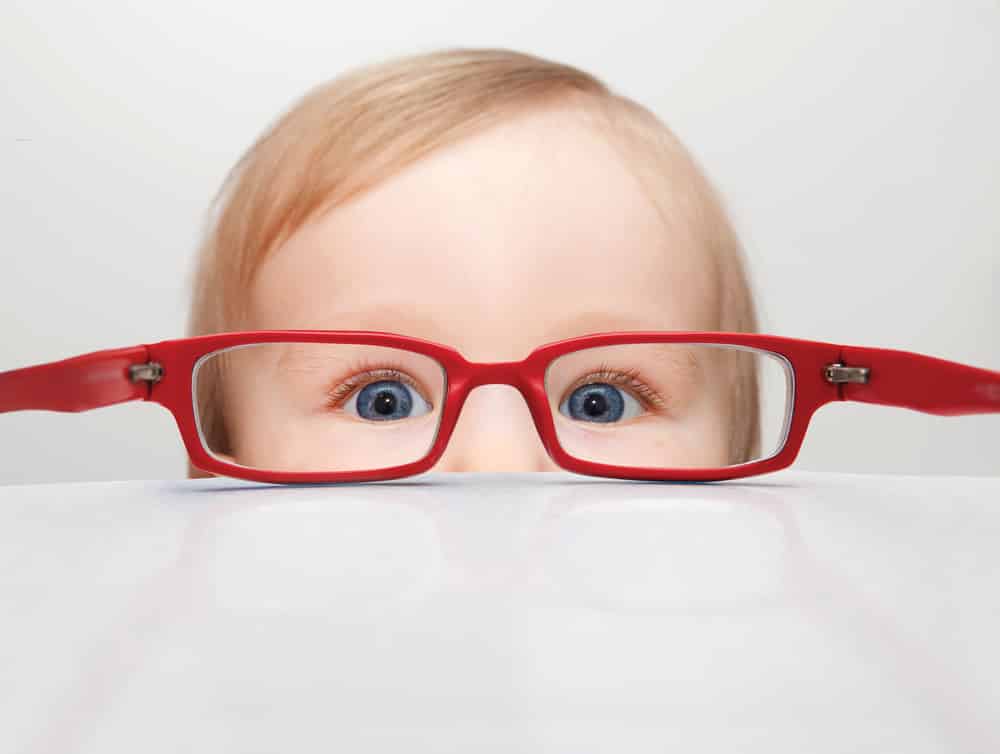Babies aren’t born knowing how to walk and talk. Their motor skills develop over time – and the same is true for their vision. While babies begin exploring the world visually from the time they’re born, vision development in babies occurs over several stages. These stages typically progress until babies are about two years old. Scroll down to find out more about these stages, and what you can do to help your baby’s vision develop properly.
Vision Development in Babies
Vision from Birth to 4 Months
Watching your baby observe the world around them is one of the best parts of being a new parent. But babies aren’t born with perfect visual acuity. Although you might see your baby staring intensely at something, newborns aren’t able to easily tell the difference between certain objects. They also have a hard time switching focus quickly. In addition, newborns tend to focus on objects less than 10 inches from their faces.
For the first two months of life, your baby’s eyes may wander or appear to be crossed. This is usually normal, but may warrant an eye doctor appointment. This is especially true if your baby’s eyes are frequently turning in or out. Keep in mind that, as your baby gets a few months older, their eyes start working together more efficiently. That means babies can usually follow objects with their eyes around three months of age. During this time, you might hang a colorful mobile above your baby’s crib so your little one can enjoy the contrasting colors and patterns.
Vision from 5 to 8 Months
Your baby’s depth perception is much more fully developed once they reach about five months of age. At this point, infants usually start reaching for objects, and they have much better color vision than younger babies. You may also notice that your baby recognizes you from across the room. And when babies start crawling – typically around eight months or age – their hand-eye coordination gets even better. During this time, you can support your baby’s visual development by carrying them in a front-facing carrier as you go about your day. Babies around this age can recognize objects in the world around them, so a quick stroll around the neighborhood can be a huge developmental boon.
Vision from 9 to 12 Months
Parents typically see a lot of mobility in babies between nine and twelve months of age. At this time, most babies crawl easily, begin to pull themselves up to a standing position, and grasp objects like toys more firmly. By the time your baby is a year old, they should be able to judge distances fairly well and throw objects toward a target, like the couch or a toy box. While babies can’t usually recognize themselves in mirrors until they’re about 15 months old, you can position them in front of a mirror around 9 to 12 months for added visual stimulation.
_____
Every baby is different. Like with many infant growth milestones, your little one may not experience these developments on a strict schedule. If you’re worried about your infant’s visual development, make sure to reach out to their pediatrician or eye doctor to detect early visual problems. While rare, vision issues in infants are much more easily treated when they’re caught early.
If you still have questions about vision development in babies, contact Heffington’s if you live in southwest Missouri. Since 1975, the Heffington family has been assisting the Springfield community with top-quality eye care and affordable eyeglasses and contacts. One of the unique features of our family-owned business is that we manufacture lenses at our own laboratory, giving us total control over the service and pricing, and we’re happy to pass our savings on to you. To learn more about our products and services, please get in touch with us online, send an email to asktheexperts@heffingtons.com, or give us a call at 417-869-3937 (Optiland location) or 417-882-3937 (House of Vision location). We look forward to hearing from you!

